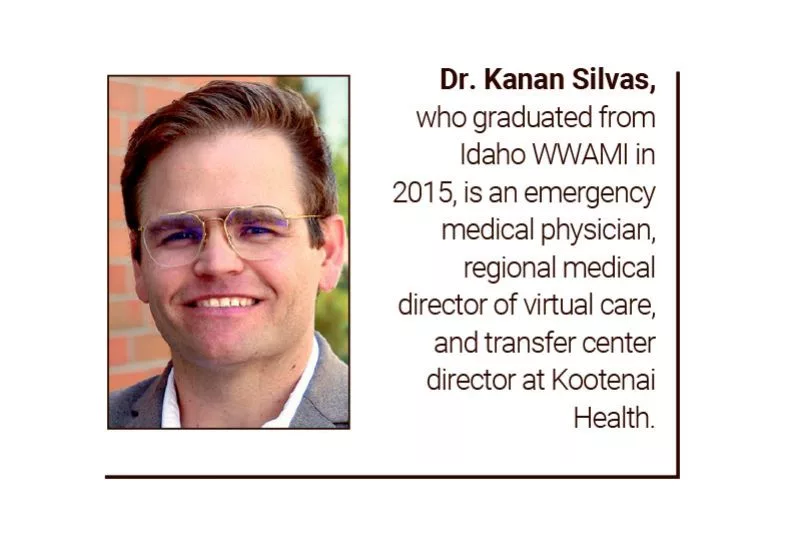Idaho WWAMI helps address physician shortage
Virtual care also helps extend providers' reach

I love living in Coeur d’Alene. I graduated from Lake City High School, and when it came time to start a family, my wife—born and raised in Coeur d’Alene—and I were intentional about doing so where we grew up.
I’ve known from a young age I wanted to pursue a career in health care, and that passion caught flame within the halls of my hometown hospital, Kootenai Health.
I have received care at Kootenai Health—appendix removal as a teenager. I have provided care in a number of capacities, first as a nursing assistant in the emergency department while an undergraduate student, then as a fourth-year Idaho WWAMI medical education student, and today as an internal medicine hospitalist and emergency medicine physician.
At Kootenai Health, I also carry the title of regional medical director of virtual care and the transfer center. Overseeing the virtual care program means I ensure local and rural populations have access to services they desperately need such as psychiatry, infectious disease, cardiology, and rheumatology. As medical director of the transfer center, I help ensure timely transfer of the region’s sickest patients and strengthen relationships with our rural partners.
From this vantage point, I see the strain the physician shortage has on Idaho’s health care system and, more importantly, Idaho residents, including my own friends and family. The physician shortage is not just a rural problem, but a statewide problem and one we are experiencing in Kootenai County as well. It is complicated to address and requires a multipronged approach to remedy. Two solutions where I see promise are investing in Idaho WWAMI medical education and a virtual care approach to medicine.
Idaho WWAMI
Supported by the state Legislature for 51 years, Idaho WWAMI is an established partnership between the University of Idaho and the University of Washington School of Medicine. It allows Idaho residents to attend a world-class medical school in their home state for in-state tuition.
As an alum, I can attest to receiving superb medical training in a wide variety of medical settings: from small primary care clinics in Lewiston, Moscow, and Plummer, Idaho, to surgery at the Boise Veterans Affairs Medical Center, to neurology and palliative care here at Kootenai Health. Through immersive training experiences and clerkships, Idaho WWAMI students gain exposure to medical care in rural settings. This is important because medical students who train in rural sites are twice as likely to practice medicine in rural areas. Even if Idaho WWAMI students end up practicing in Coeur d’Alene, their medical school education helps shape their sensitivity to patients who live in rural Idaho, as well as their colleagues who practice there.
Kootenai Health has been a clerkship site for Idaho WWAMI since 2005 and is also home to the only family medicine residency in North Idaho, which prepares physicians to work in rural or urban settings. Most of the residency graduates stay in Idaho—20 out of 36 graduates are practicing in-state—just like most Idaho WWAMI alum opt to practice in the Gem State—51%, which is well above the national average of 39%. WWAMI medical students train where they were raised and as a result have a higher rate of practicing here, too. I’m proof the Idaho WWAMI physician pathway works.
Virtual care
Despite Idaho WWAMI’s decades-long presence in the state, Idaho faces a physician shortage, recently made more acute by factors such as burnout and baby boomer retirement. Kootenai Health providers have always traveled throughout northern Idaho for patient care, but in recent years the demand has grown exponentially as these communities continue to lose physicians.
When I first started at Kootenai Health in 2020, I regularly worked in Orofino, almost three hours away. Today, some of my colleagues travel on a weekly basis to clinics as far north as Bonners Ferry and as far south as Grangeville. Depending on road conditions, it can be dangerous to make these trips. The time it takes to drive could be better spent seeing more patients, who face hardships themselves when commuting to in-person appointments. An appointment that requires a patient to travel is compounded by factors like requesting time off of work, child care, transport, and costs associated with overnight travel expenses.
This year, the Idaho Legislature passed House Bill 162, the Virtual Care Access Act, to address the ongoing needs of Idahoans through virtual care. I applaud the Legislature for this decision to ensure the residents of Idaho are able to receive access to needed care. Virtual care covers a wide variety of care delivery modalities, including live video visits between a provider and patient, as well as asynchronous opportunities like paperwork submission and chart reviews. There are stipulations in place to ensure that a doctor-patient relationship is established; where that is not the case, in-person appointments would be encouraged. I’ve seen firsthand how virtual care expedites physician-patient communication without sacrificing level of care.
Idaho WWAMI medical education trains students to care for the communities in which they were raised. Paired with advances in virtual care, our homegrown physicians can help address gaps our health care systems are grappling with. Including more timely diagnosis, specialized treatment, and perhaps most importantly, better outcomes and quality of life for Idahoans.
Related Articles

_c.webp?t=1763626051)
_web.webp?t=1764835652)

